Perceptions and Adaptive Behaviors of Farmers
Abstract
1. Introduction
2. Materials and Methods
2.1. Study Area
2.2. Questionnaire Design and Data Acquisition
2.3. Research Methodology
2.3.1. Theoretical Framework of the Study
2.3.2. General Characteristics of Farmers
2.3.3. Perceived Intensity of Drought Among Farmers
2.3.4. Degree of Diversification of Farmers’ Adaptation Behavior to Drought
2.3.5. Impact of Farmers’ Drought Perceptions on Adaptive Behavioral Choices
3. Results
3.1. Reliability and Validity Tests
3.2. General Characteristics of Farmers
3.3. Farmers’ Perception of Drought
3.3.1. Farmers’ Risk Perception of Drought
3.3.2. Farmers’ Perception of Adaptation to Drought
3.4. The Adaptation Behaviors of Farmers to Drought
3.5. Impact of Farmers’ Drought Perceptions on Adaptive Behavioral Choices
- (1)
- Water Resource Management
- (2)
- Crop Management
- (3)
- Non-Agricultural Measures
4. Discussion
4.1. Classification of Drought Adaptation Behavior of Farmers in Dry-Hot Karst Valley Area
- (1)
- Technological adaptation
- (2)
- Behavioral adaptation
- (3)
- Economic adaptation
4.2. Peculiarities of Farmers’ Adaptive Behavior to Drought in the Karst Dry-Hot Valley Area
4.3. Reasons for Differences in the Perception of Drought by Different Farmers
4.4. Recommendations
- (1)
- Improve farmers’ perception of drought adaptation and increase their motivation to react to drought.
- (2)
- Behaviorally-informed drought adaptation policies.
4.5. Limitations
5. Conclusions
Author Contributions
Funding
Data Availability Statement
Conflicts of Interest
References
- Gao, Y.; Wang, X.; Xiong, J.; Wu, H.; Li, X.; Cai, S.; Zhang, Z. Practice and reflection on climate change research from the perspective of geographical science. Geogr. Res. 2023, 42, 2817–2826. [Google Scholar]
- Zhao, Z.; Wang, K. Capability of existing drought indices in reflecting agricultural drought in China. J. Geophys. Res. Biogeosci. 2021, 126, e2020JG006064. [Google Scholar] [CrossRef]
- Yang, X.; Wang, J.; Liu, K.; Zhang, X. Quantative analysis on farmer’s resilience toward drought, a case study of Yuzhong County, Gansu Province. J. Arid. Land Resour. Environ. 2010, 24, 101–106. [Google Scholar] [CrossRef]
- Yang, F.; An, G.; Sun, F.; He, X. The selection of drought index and leveling its division of natural grassland around qinghai lake. Qinghai Pratacult. 2022, 31, 26–30. [Google Scholar]
- Sun, C.; Wei, Y.; Zhao, L. Co-evolution of water-energy-food nexus in arid areas: Take Northwest China as an example. J. Nat. Resour. 2022, 37, 320–333. [Google Scholar] [CrossRef]
- Shi, X.; Sun, L.; Chen, X.; Wang, L. Farmers’ perceived efficacy of adaptive behaviors to climate change in the Loess Plateau, China. Sci. Total Environ. 2019, 697, 134217. [Google Scholar] [CrossRef]
- Udmale, P.; Ichikawa, Y.; Manandhar, S.; Ishidaira, H.; Kiem, A.S. Farmers’ perception of drought impacts, local adaptation and administrative mitigation measures in Maharashtra State, India. Int. J. Disaster Risk Reduct. 2014, 10, 250–269. [Google Scholar] [CrossRef]
- Aliyar, Q.; Zulfiqar, F.; Datta, A.; Kuwornu, J.K.; Shrestha, S. Drought perception and field-level adaptation strategies of farming households in drought-prone areas of Afghanistan. Int. J. Disaster Risk Reduct. 2022, 72, 102862. [Google Scholar] [CrossRef]
- Zhao, X. Environmental perception of farmers of different livelihood strategies: A case of Gannan Plateau. Acta Ecol. Sin. 2012, 32, 6776–6787. [Google Scholar] [CrossRef]
- Wang, X.; Lu, Q.; Lu, Q. Impact of water scarcity perception on farmers’irrigation adaptive behaviors in northern well-irrigated areas in China. J. Arid. Land Resour. Environ. 2019, 33, 159–164. [Google Scholar] [CrossRef]
- Quandt, A. Coping with Drought: Narratives from Smallholder Farmers in Semi-Arid Kenya. Int. J. Disaster Risk Reduct. 2021, 57, 102168. [Google Scholar] [CrossRef]
- Hou, L.; Huang, J.; Wang, J. Early warning information, farmers’ perceptions of, and adaptations to drought in China. Clim. Change 2017, 141, 197–212. [Google Scholar] [CrossRef]
- Islam, M.S.; Hossain, M.Z.; Sikder, M.B. Drought adaptation measures and their effectiveness at Barind Tract in northwest Bangladesh: A perception study. Nat. Hazards: J. Int. Soc. Prev. Mitig. Nat. Hazards 2019, 97, 1253–1276. [Google Scholar] [CrossRef]
- Wei, G.; Shi, X.; Sun, L.; Wang, L.; Li, H. The farmers’ perception of climate change and diversity of adaptive behavior in dry farming region. J. Shaanxi Norm. Univ. Nat. Sci. Ed. 2020, 48, 116–124. [Google Scholar] [CrossRef]
- Udmale, P.D.; Ichikawa, Y.; Manandhar, S.; Ishidaira, H.; Kiem, A.S.; Shaowei, N.; Panda, S.N. How did the 2012 drought affect rural livelihoods in vulnerable areas? Empirical evidence from India. Int. J. Disaster Risk Reduct. 2015, 13, 454–469. [Google Scholar] [CrossRef]
- Soubry, B.; Sherren, K.; Thornton, T.F. Are we taking farmers seriously? A review of the literature on farmer perceptions and climate change, 2007–2018. J. Rural Stud. 2020, 74, 210–222. [Google Scholar] [CrossRef]
- Yarong, L.; Minpeng, C. Farmers’ perception on combined climatic and market risks and their adaptive behaviors: A case in Shandong Province of China. Environ. Dev. Sustain. 2021, 23, 13042–13061. [Google Scholar] [CrossRef]
- Hou, L.; Wang, J.; Huang, J. Farmers’ perceptions of extreme drought events at different income levels and their impacts on the adoption of adaptation measures-an empirical analysis based on a large-scale survey of farmers in nine provinces across China. Agric. Technol. Econ. 2016, 11, 24–33. [Google Scholar] [CrossRef]
- Hartmann, A.; Goldscheider, N.; Wagener, T.; Lange, J.; Weiler, M. Karst water resources in a changing world: Review of hydrological modeling approaches. Rev. Geophys. 2015, 52, 218–242. [Google Scholar] [CrossRef]
- Deng, Y.; Wang, S.; Bai, X.; Luo, G.; Wu, L.; Chen, F.; Wang, J.; Li, Q.; Li, C.; Yang, Y.; et al. Spatiotemporal dynamics of soil moisture in the karst areas of China based on reanalysis and observations data. J. Hydrol. 2020, 585, 124744. [Google Scholar] [CrossRef]
- Peng, J.; Yang, M. Analysis of soil erosion status in the Huajiang Karst Canyon, Guizhou. J. Mt. Geol. 2001, 6, 511–515. [Google Scholar]
- Xiong, K.; Li, J.; Long, M. Features of Soil and Water Loss and Key Issues in Demonstration Areas for Combating Karst Rocky Desertification. Acta Geogr. Sin. 2012, 67, 878–888. [Google Scholar]
- Li, Y.; Wang, S.; Li, R.; Xiong, K. Preliminary Study on the Causes of Rocky Desertification in Huajiang Karst Gorge Area. Adv. Earth Sci. 2006, 21, 526–533. [Google Scholar]
- Cai, L.; Xiong, K.; Li, Y.; Liu, Z.; Zhu, D.; Liang, H.; Mu, Y.; Chen, Y. Coexisting plants restored in karst desertification areas cope with drought by changing water uptake patterns and improving water use efficiency. J. Hydrol. 2025, 654, 132813. [Google Scholar] [CrossRef]
- Guizhou Meteorological Bureau. Prediction of Agricultural Meteorological Impacts in Guizhou Province in 2025; Guizhou Meteorological Bureau: Guiyang, China, 2025. [Google Scholar]
- Institute of Karst Geology, Guizhou Normal University. Research on Vegetation Type Selection in Huajiang Gorge Area; Guizhou Normal University: Guiyan, China, 2023. [Google Scholar]
- Xiong, K.N. “Huajiang Model” of Karst Rocky Desertification Control; Science Press: Beijing, China, 2020. [Google Scholar]
- Yang, Z.; Ke, Q.; Ma, Q.; Cao, Z.; Zhang, K.; Yang, Y. Response of Soil Moisture to Rainfall on Karst Yellow Soil Slope. J. Soil Water Conserv. 2021, 35, 75–79. [Google Scholar] [CrossRef]
- Grothmann, T.; Patt, A. Adaptive capacity and human cognition: The process of individual adaptation to climate change. Glob. Environ. Change 2005, 15, 199–213. [Google Scholar] [CrossRef]
- Bartlett, J.E.; Joe, W.; Kotrlik, J.W.; Higgins, C.C. Organizational Research: Determining appropriate sample size in survey research. Inf. Technol. Learn. Perform. J. 2001, 19, 43–50. [Google Scholar]
- Zhao, X.; Xue, B. Farmers’ Perception of Water Resource Shortage and Adaption in Continental River Basin of Arid Zone: A Case of the Middle-lower Reaches of the Shiyang River. Sci. Geosci. Sin. 2015, 35, 1622–1630. [Google Scholar] [CrossRef]
- Hao, H.; Zhang, J.; Li, X.; Zhang, H.; Zhang, Q. Impact of livelihood diversification of rural households on their ecological footprint in agro-pastoral areas of northern China. J. Arid. Land 2015, 7, 653–664. [Google Scholar] [CrossRef]
- Yan, J.; Wu, Y.; Zhang, Y.; Zhou, S.; Shi, Y. Livelihood Diversification of Peasants and Nomads of Eastern Transect in Tibetan Plateau. Acta Geogr. Sin. 2009, 64, 221–233. [Google Scholar]
- Zhang, C. Adaptation Behavior of Farmers to Multiple Drought Type Superimposed Environments in Dry-Hot Valley; Guizhou Normal University: Guiyang, China, 2023. [Google Scholar] [CrossRef]
- Wang, J.; Peng, J.; Zhang, R.; Xu, Z.; Liu, Y. Research progress and prospect of karst ecosystem services. J. Guizhou Norm. Univ. Nat. Sci. 2024, 42, 77–84 + 105. [Google Scholar]
- Luo, Y.; Zhang, R.; Xue, X.; Liu, M.; Wang, J.; Lou, J. Research on karst landform classification based on positive and negative terrains. J. Guizhou Norm. Univ. Nat. Sci. 2024, 42, 9–19. [Google Scholar] [CrossRef]
- Twongyirwe, R.; Mfitumukiza, D.; Barasa, B.; Naggayi, B.R.; Odongo, H.; Nyakato, V.; Mutoni, G. Perceived effects of drought on household food security in South-western Uganda: Coping responses and determinants. Weather Clim. Extrem. 2019, 24, 100201. [Google Scholar] [CrossRef]
- Cook, B.I.; Ault, T.R.; Smerdon, J.E. Unprecedented 21st century drought risk in the American Southwest and Central Plains. Sci. Adv. 2015, 1, e1400082. [Google Scholar] [CrossRef]
- Koch, J.; Zhang, W.; Martinsen, G.; He, X.; Stisen, S. Estimating net irrigation across the North China Plain through dual modelling of evapotranspiration. J. Water Resour. Res. 2020. [Google Scholar] [CrossRef]
- Matewos, T. The State of Local Adaptive Capacity to Climate Change in Drought-Prone Districts of Rural Sidama, Southern Ethiopia. Clim. Risk Manag. 2019, 27, 100209. [Google Scholar] [CrossRef]
- Maldonado-Méndez, M.D.L.; Romo-Lozano, J.L.; Monterroso-Rivas, A.I. Determinant Indicators for Assessing the Adaptive Capacity of Agricultural Producers to Climate Change. Atmosphere 2022, 13, 1114. [Google Scholar] [CrossRef]
- IPCC. Part B: Regional Aspects. Contribution of Working Group II to the Fifth Assessment Report of the Intergovernmental Panel on Climate Change; IPCC: Geneva, Switzerland, 2014. [Google Scholar]
- Jia, X.; Wei, C.; Yu, Y. Huajiang Dry-Hot Valley in Central Guizhou Province: Crrent Knowledge and Prespectives. J. Jishou Univ. Nat. Sci. 2024, 45, 56–62. [Google Scholar] [CrossRef]
- Pan, L. A Study on the Operating Mechanism of the Dragon Fruit Farmer Cooperative in Guanling County; Guizhou University for Nationalities: Guiyang, China, 2020. [Google Scholar] [CrossRef]
- Li, Y. Effect of Planting Combinations on Soil Fertility and Functional Traits of Zanthoxylum planispinum var. Dintanensis Plantations in Huajiang Scenic Area; Guizhou Normal University: Guiyang, China, 2023. [Google Scholar]
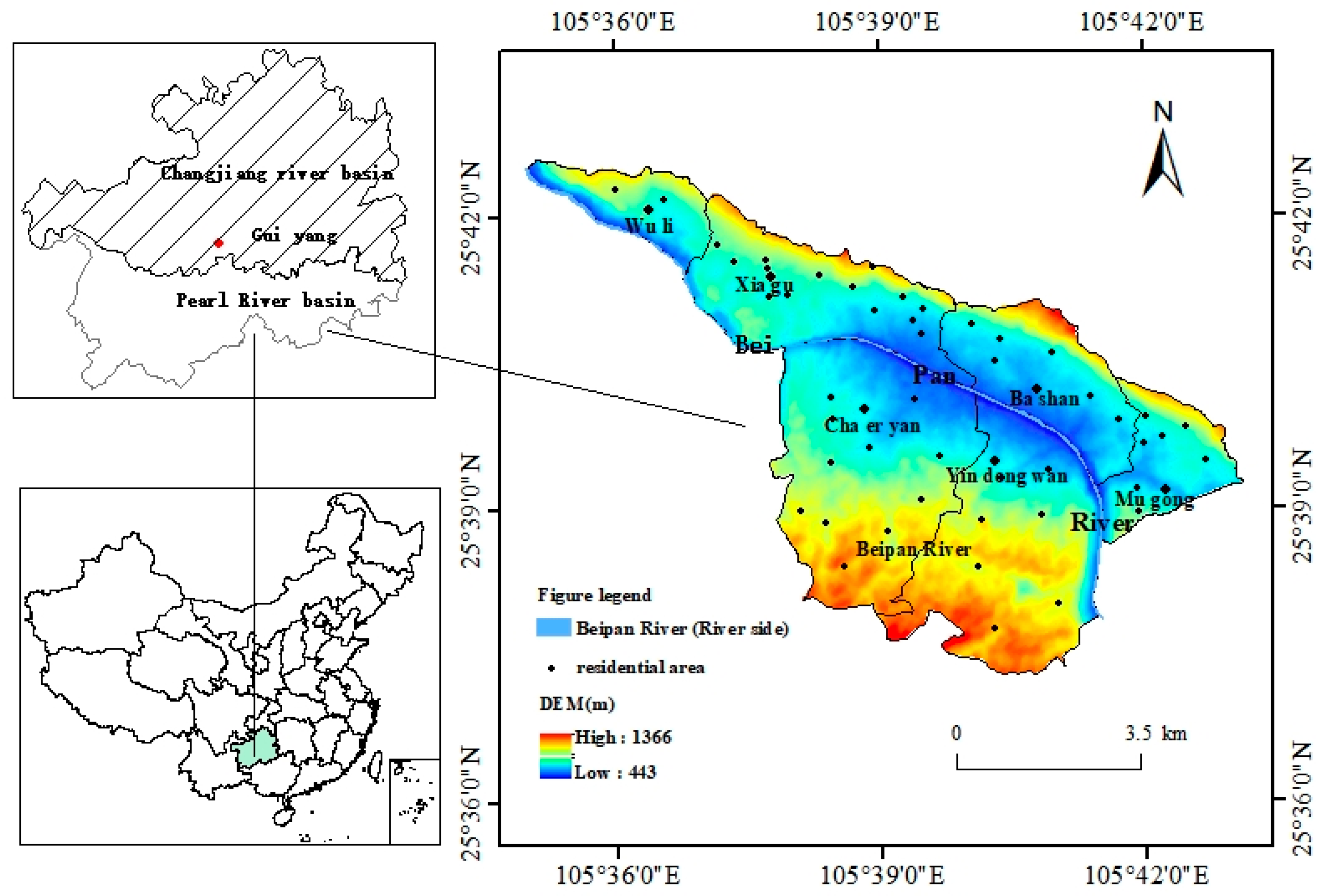
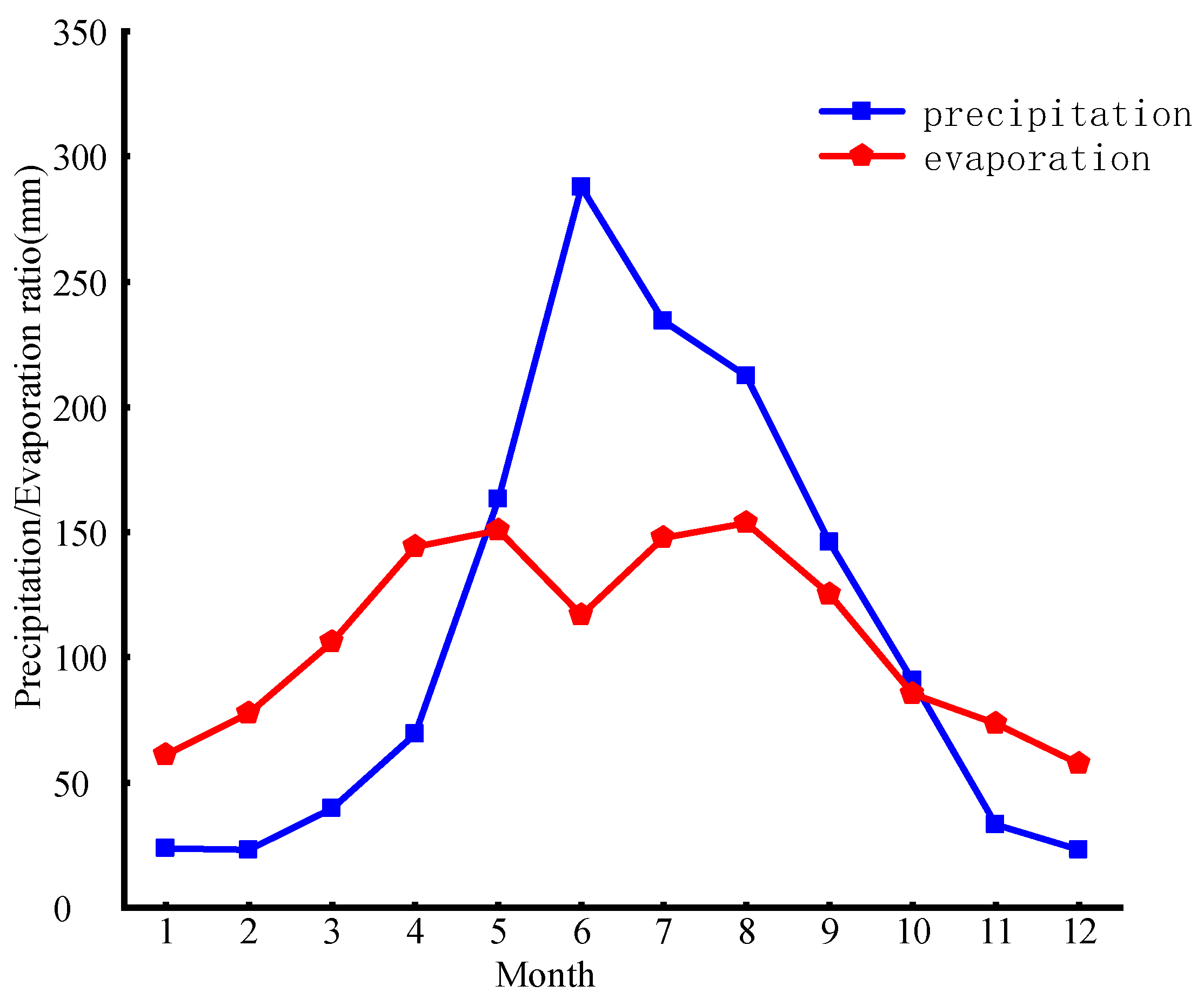
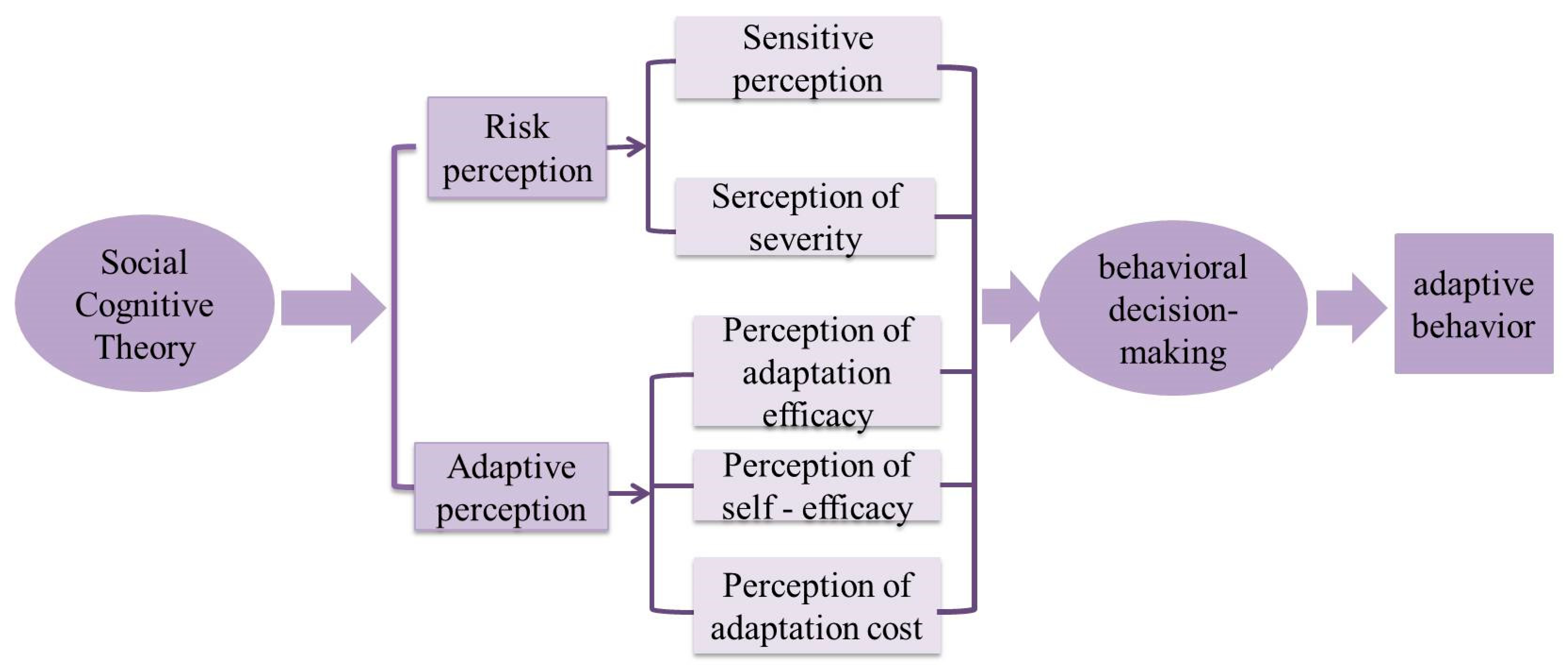
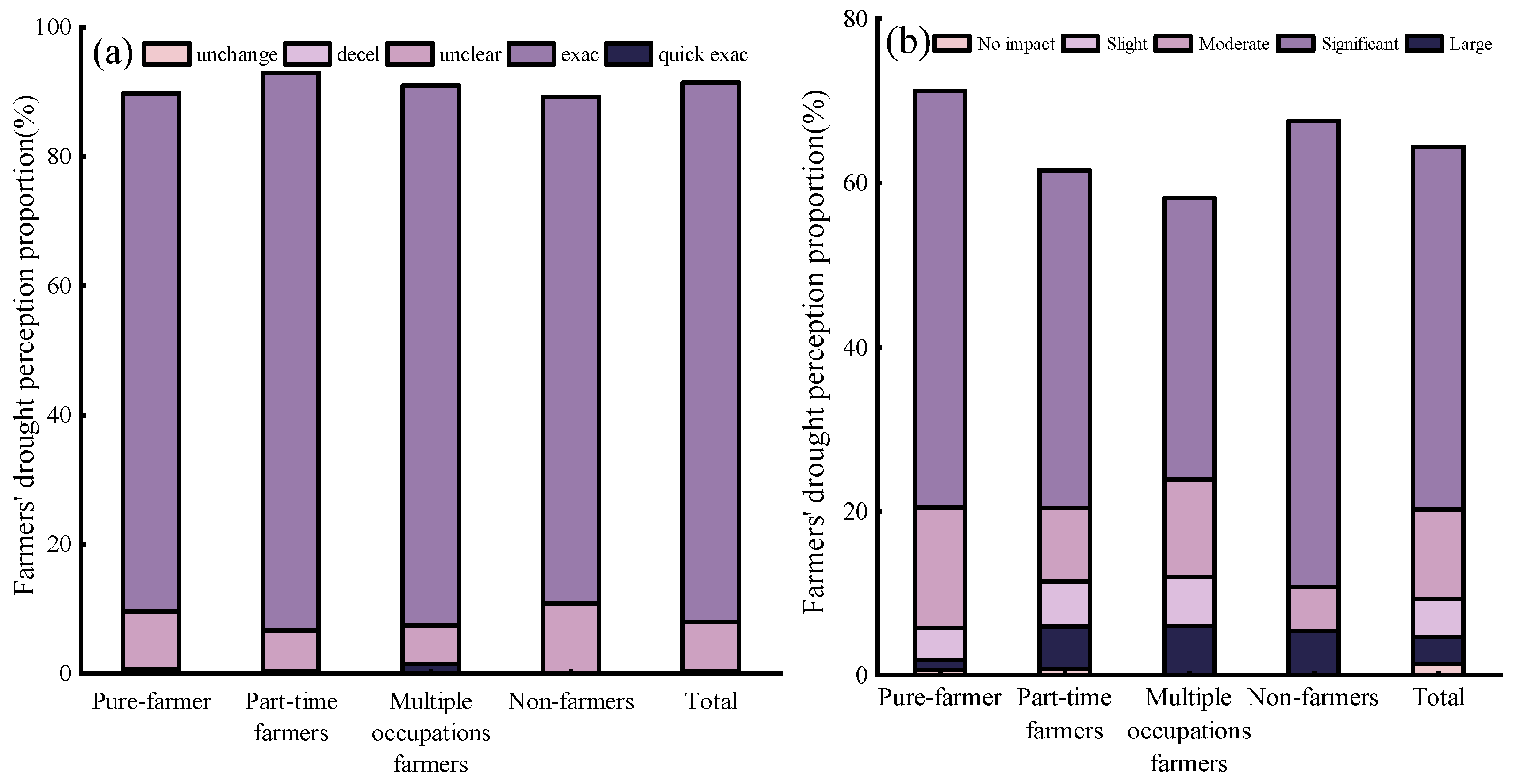
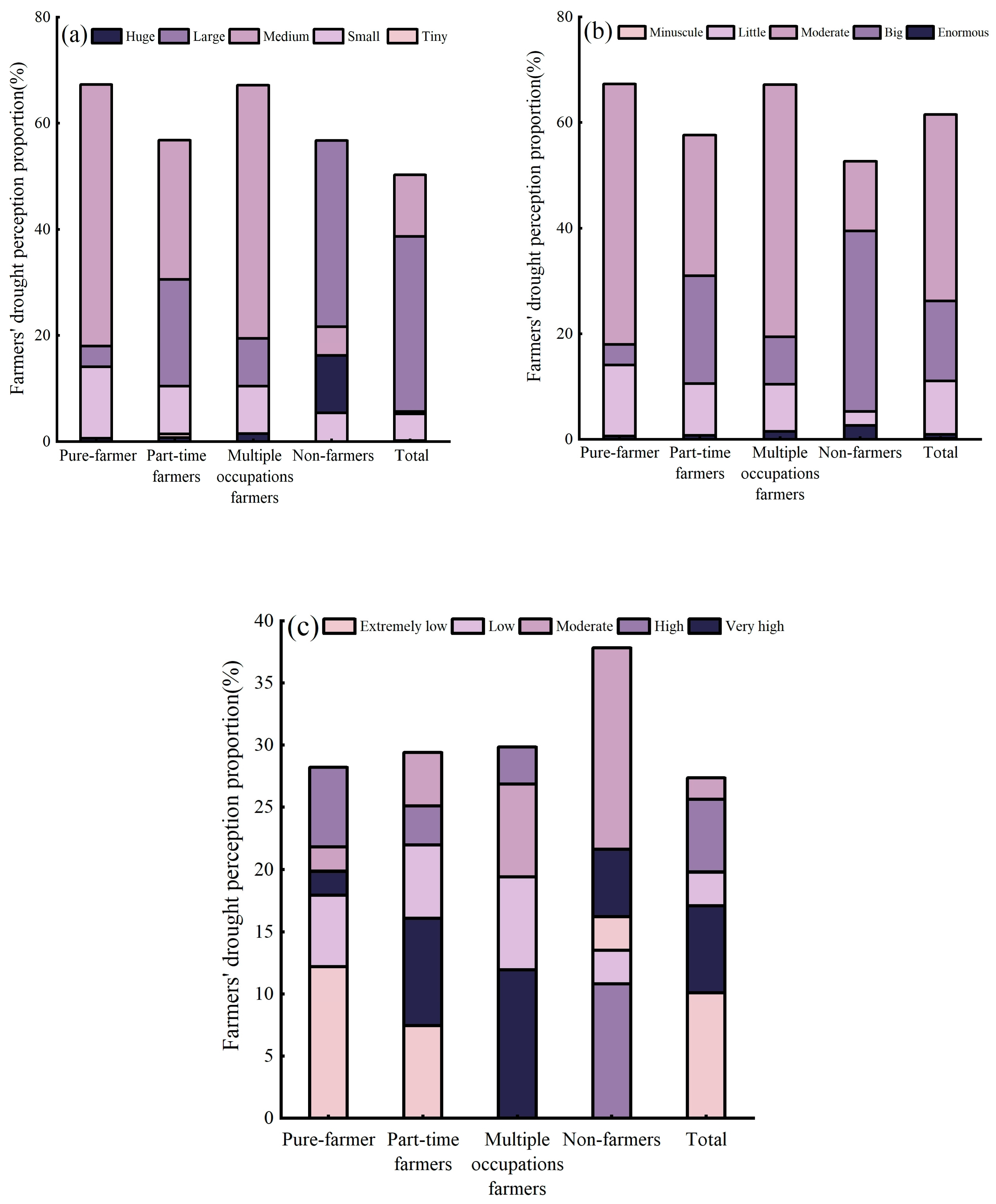
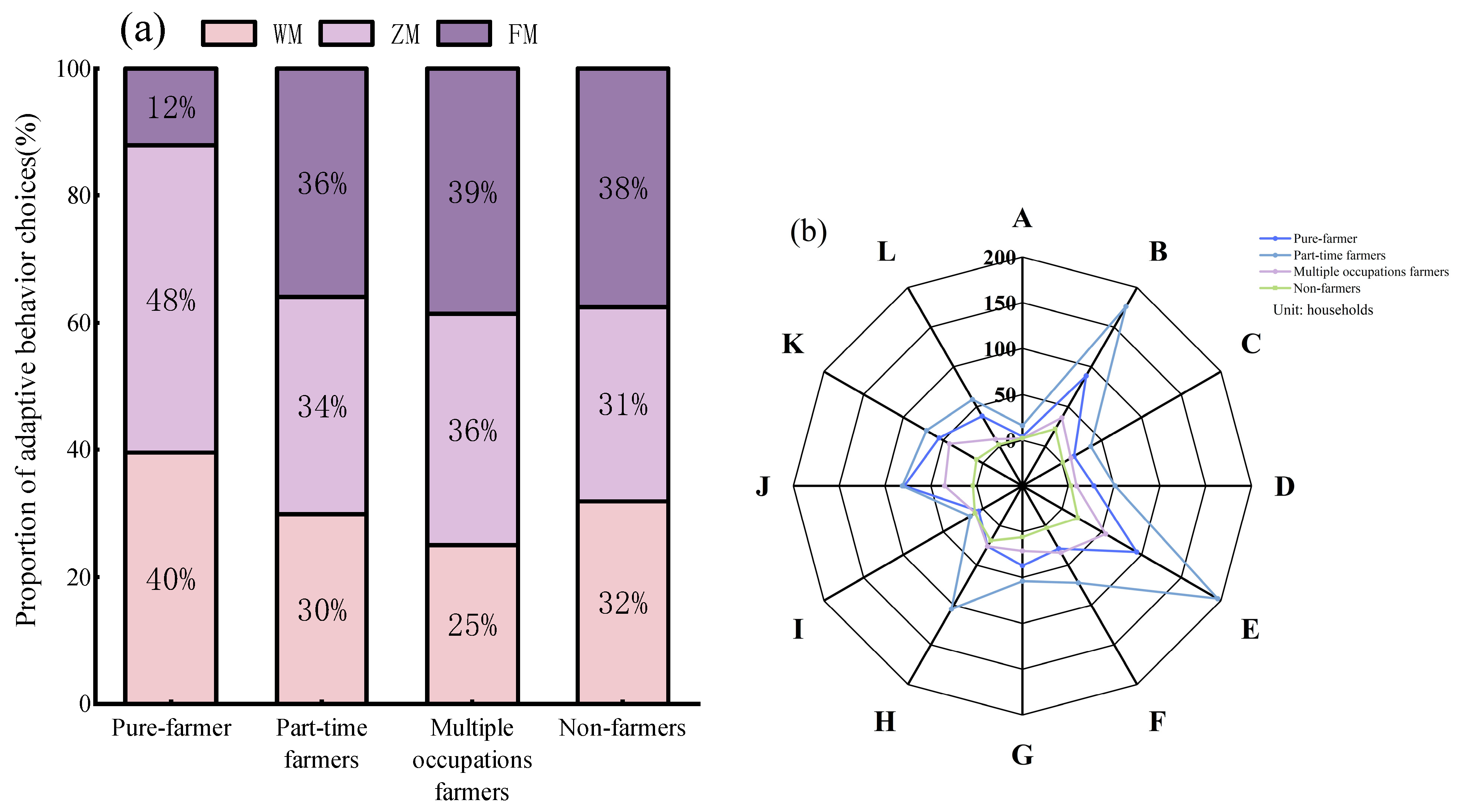
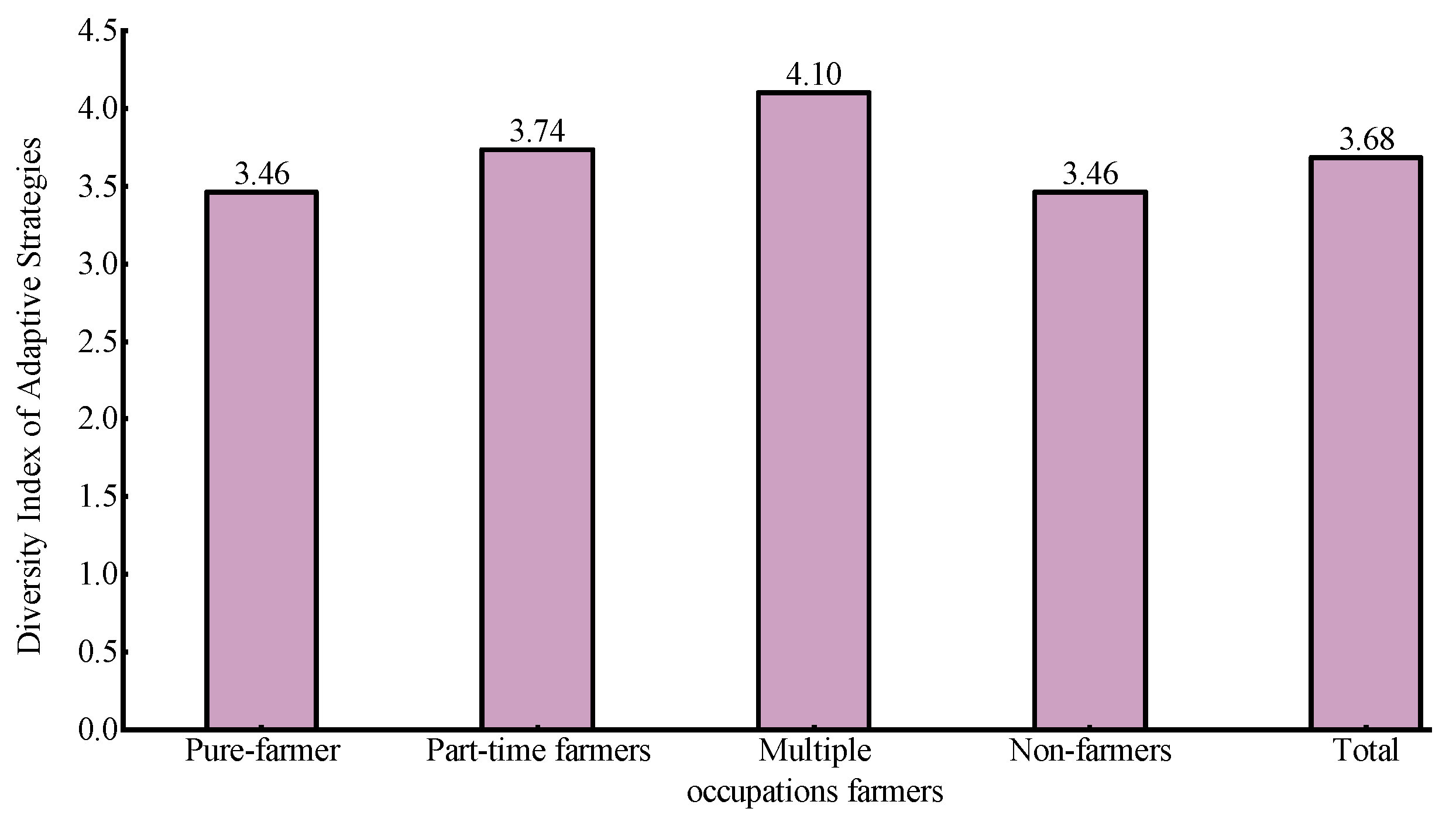
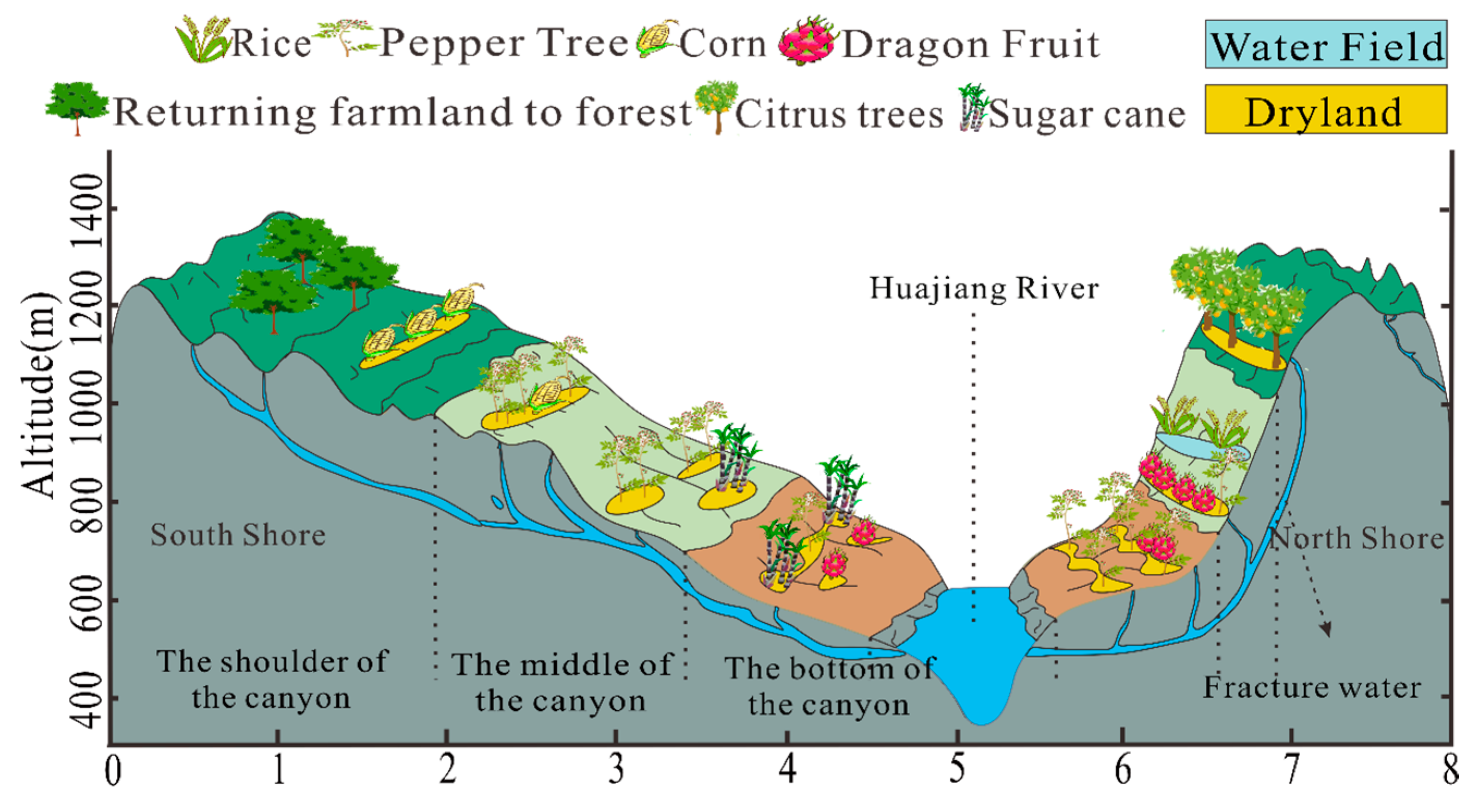
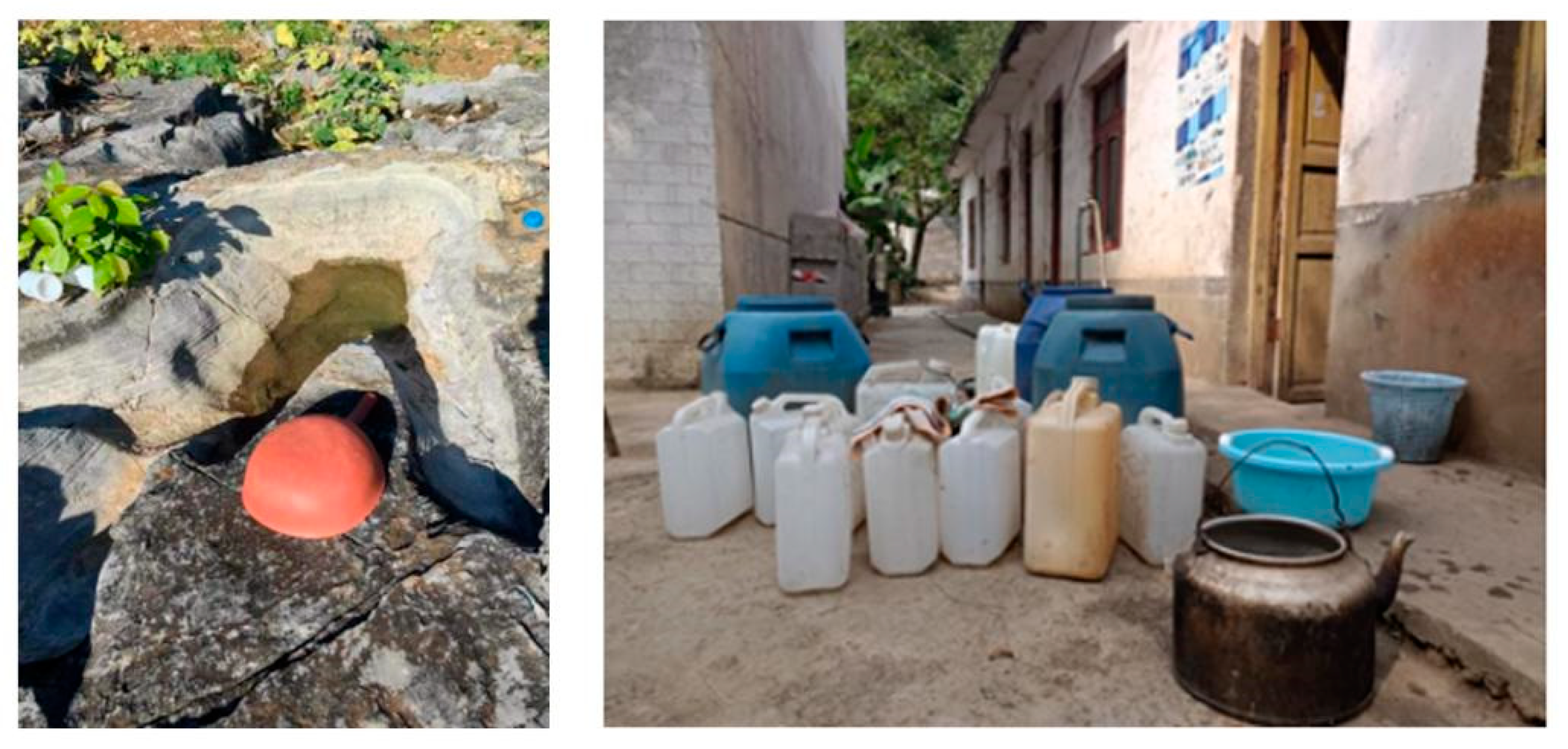
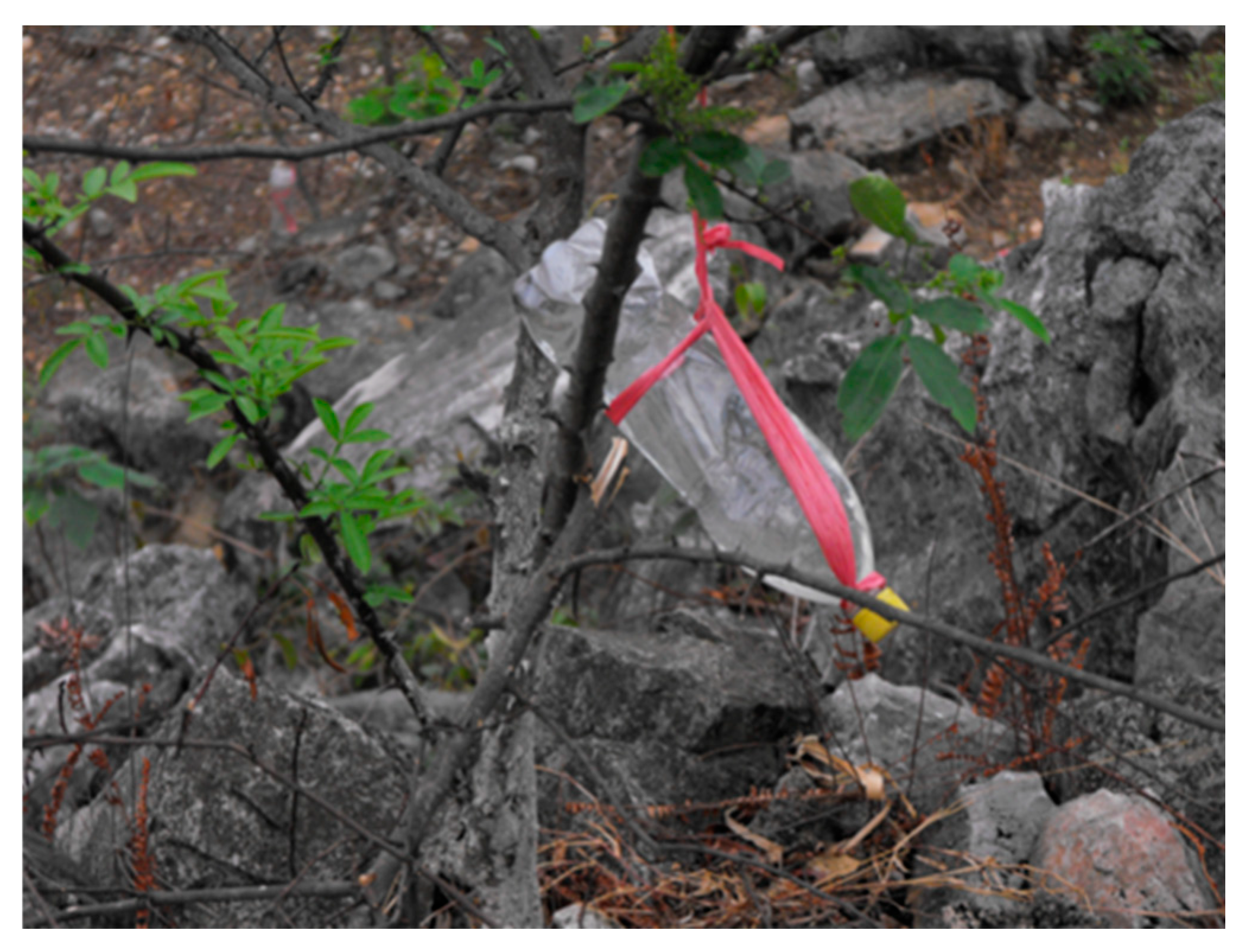
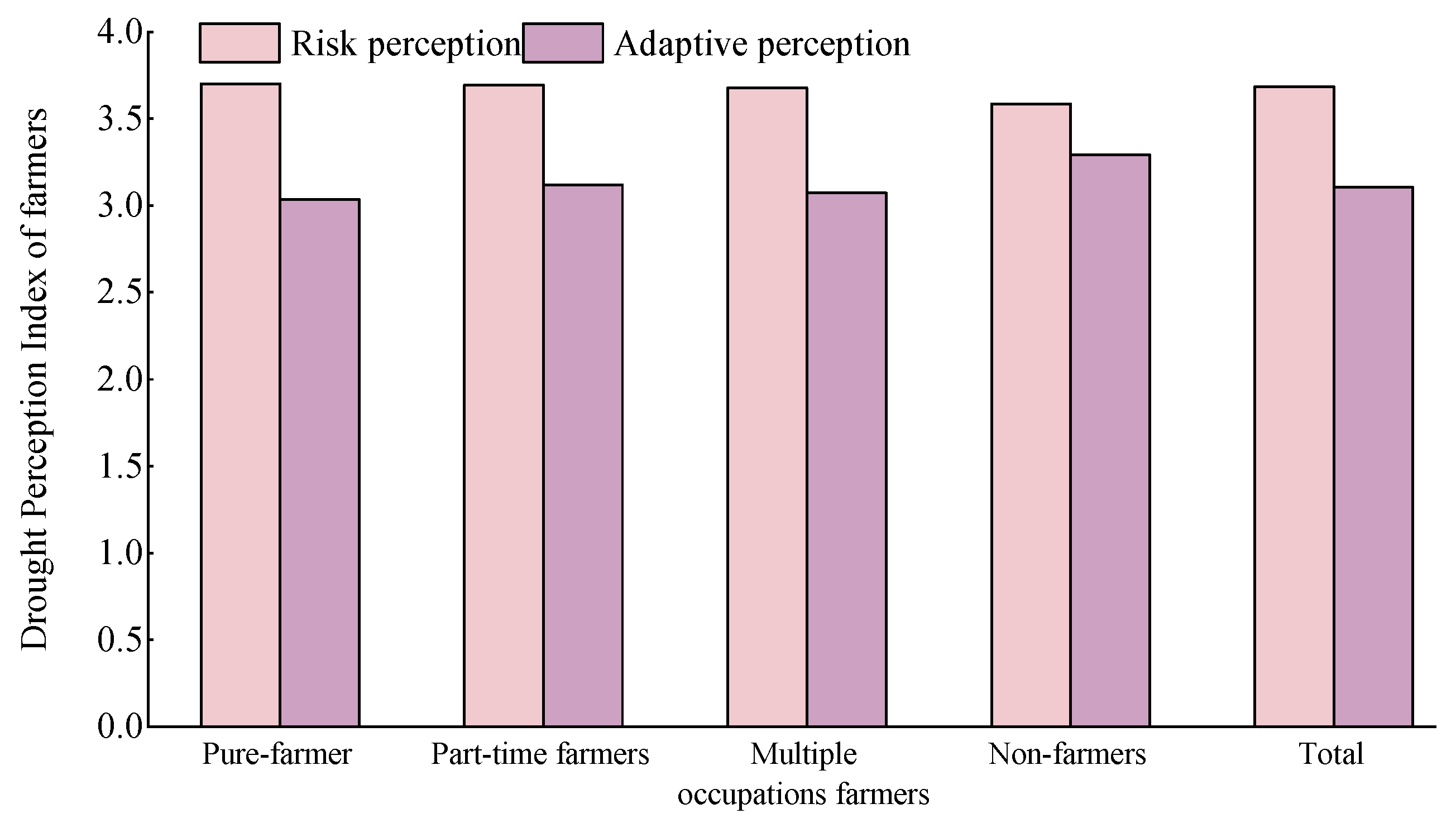
| Indicator | Measurement Item | Scoring | |
|---|---|---|---|
| Risk Perception | Perceived sensitivity (X1) | How do you anticipate future drought trends in your locality? | Rapid intensification = 5; Intensification = 4; Uncertain = 3; Mitigation = 2; No change = 1 |
| Perceived severity (X2) | To what extent does drought impact your production and livelihood? | Extreme = 5; Significant = 4; Moderate = 3; Minor = 2; None = 1 | |
| Perceived efficacy (X3) | How effective are your current drought adaptation measures? | Excellent = 5; Good = 4; Moderate = 3; Poor = 2; Very poor = 1 | |
| Adaptation Perception | Self-efficacy (X4) | How would you assess your capability to adapt to drought? | Very strong = 5; Strong = 4; Moderate = 3; Weak = 2; Very weak = 1 |
| Perceived cost (X5) | How would you evaluate the cost of implementing drought adaptation measures? | Very high = 5; High = 4; Moderate = 3; Low = 2; Very low = 1 |
| Variable | Definition | Mean | SD |
|---|---|---|---|
| Age | Actual age of household head (years) | 52.16 | 16.00 |
| Labor force | Proportion of working-age population (18–60 years) to total household members | 3.23 | 1.71 |
| Farming experience | Years engaged in agricultural activities | 30.07 | 15.50 |
| Annual income per capita | Cash income per person | 1.87 | 1.00 |
| Cultivated land area | Total farmland area (mu) | 12.97 | 12.36 |
| Diversification index | Diversity of drought adaptation behaviors adopted | 3.68 | 1.44 |
| Type of Farmers | Main Sources of Livelihood |
|---|---|
| Pure farmers | Farming |
| Part-time farmers | Farming + Services (Education, Health care, Administration), farming + Labor, Farming + Small business, Farming + Child support, Farming + Government subsidies |
| Multiple occupations farmers | Farming + Labor + Services (Education, Healthcare, Administration), Farming + Labor + Others, Farming + Labor + Government Financial Subsidies, Farming + Labor + Small Businesses, Farming + Labor + Small Businesses |
| Non-farmers | Services (education, health care, administration), Small business, Five-guarantee households, Government financial subsidies, Labor, Labor + Small business, Child support, Small business + Other |
| Type | Number | Proportion % | Family Size Person/ Household | Labor Force Persons/ Household | Educational Attainment of Labor Force % | Average Annual Household Income | ||||
|---|---|---|---|---|---|---|---|---|---|---|
| Illiterate | Primary SCHOOL | Junior High School | Senior High School | College and Above | Ten Thousand | |||||
| pure farmers | 156 | 30.29 | 5.20 | 2.81 | 25.00 | 41.67 | 26.28 | 3.21 | 3.85 | 1.82 |
| part-time farmers | 255 | 49.51 | 5.56 | 3.50 | 29.02 | 35.29 | 27.06 | 5.49 | 3.14 | 1.89 |
| multiple occupations farmers | 67 | 13.01 | 5.70 | 3.76 | 28.36 | 28.36 | 25.37 | 2.99 | 14.93 | 1.83 |
| non-farmers | 37 | 7.18 | 4.27 | 2.22 | 10.81 | 43.24 | 37.84 | 5.41 | 2.70 | 2.04 |
| total | 515 | 100.00 | 5.37 | 3.44 | 26.41 | 36.89 | 27.38 | 4.47 | 4.85 | 1.72 |
| Type | Risk Perception | Adaptive Perception | |||||
|---|---|---|---|---|---|---|---|
| Sensitivity Perception | Severity Perception | Mean | Perceived Adaptation Efficacy | Perceived Self-Efficacy | Perceived Adaptation Costs | Mean | |
| Pure farmers | 3.72 | 3.68 | 3.70 | 3.14 | 2.88 | 3.09 | 3.04 |
| Multiple occupations farmers | 3.80 | 3.59 | 3.70 | 3.28 | 3.06 | 3.02 | 3.12 |
| Part-time farmers | 3.75 | 3.61 | 3.68 | 3.41 | 2.91 | 2.90 | 3.07 |
| Non-farmers | 3.71 | 3.46 | 3.59 | 3.61 | 3.30 | 2.97 | 3.29 |
| Total | 3.76 | 3.61 | 3.69 | 3.28 | 3.00 | 3.03 | 3.10 |
| Adaptation Behavior | Specific Measures | Prevalence (%) |
|---|---|---|
| Water Resource Management | Constructing ponds/reservoirs Reducing cultivated land area Decreasing irrigation frequency | 70.49 |
| Crop Management | Adjusting planting/harvest dates Cultivating drought-resistant varieties Implementing crop diversification/intercropping Applying organic fertilizers | 84.08 |
| Non-agricultural Measures | Selling livestock/poultry Seasonal off-farm labor migration Small-scale entrepreneurship Participating in paid temporary farm work Accessing formal/informal loans | 88.93 |
| Predictor | Water Resource Management | Crop Management | Non-Agricultural Measures |
|---|---|---|---|
| β (SE) | β (SE) | β (SE) | |
| Risk Perception | −0.65 * | −0.24 | −0.30 |
| Risk Sensitivity | −0.04 | 0.06 | −0.12 |
| Perceived Adaptation Efficacy | 0.41 ** | 0.13 | 0.42 * |
| Perceived Self-Efficacy | 0.47 ** | −0.01 | −0.96 *** |
| Perceived Adaptation Costs | 0.50 *** | 0.12 | 0.40 *** |
| Age | −1.70 * | −0.87 * | −0.94 |
| Labor Force Ratio | −0.67 | 2.12 | 0.06 |
| Farming Experience | 2.03 ** | 0.78 | −0.16 |
| Annual Income | 0.67 | −1.19 | 1.15 |
| Cultivated Land Area | −1.12 | 0.68 | 2.71 |
| R2 | 0.14 | 0.03 | 0.10 |
| Divergent Strategies | Semi-Arid Areas (Climatic Arid Regions) | Karst Dry-Hot Valley Areas (Non-Climatic Arid Regions) |
| Crop management & non-agricultural measures | Cultivation of drought-resistant crops Modification of planting/harvesting calendars Crop diversification/intercropping Application of organic fertilizers Adjustment of cropping patterns Crop insurance adoption Seasonal off-farm employment | |
| Water resource management | Composite surface water substitution and management strategies: Enhanced groundwater exploitation Reduction of irrigated areas Installation of surface/subsurface pipelines Dry seedling bed preparation Water diversion system improvements | Surface water management-based strategies: Reduced irrigation frequency Cultivated land contraction Closed karst depression water storage Construction of rainwater harvesting cisterns |
Disclaimer/Publisher’s Note: The statements, opinions and data contained in all publications are solely those of the individual author(s) and contributor(s) and not of MDPI and/or the editor(s). MDPI and/or the editor(s) disclaim responsibility for any injury to people or property resulting from any ideas, methods, instructions or products referred to in the content. |
© 2025 by the authors. Licensee MDPI, Basel, Switzerland. This article is an open access article distributed under the terms and conditions of the Creative Commons Attribution (CC BY) license (https://creativecommons.org/licenses/by/4.0/).
Share and Cite
Wang, J.; Luo, Y.; Ruan, Y.; Yang, S.; Dong, G.; Li, R.; Yin, W.; Liang, X. Perceptions and Adaptive Behaviors of Farmers. Water 2025, 17, 1993. https://doi.org/10.3390/w17131993
Wang J, Luo Y, Ruan Y, Yang S, Dong G, Li R, Yin W, Liang X. Perceptions and Adaptive Behaviors of Farmers. Water. 2025; 17(13):1993. https://doi.org/10.3390/w17131993
Chicago/Turabian StyleWang, Jiaojiao, Ya Luo, Yajie Ruan, Shengtian Yang, Guotao Dong, Ruifeng Li, Wenhao Yin, and Xiaoke Liang. 2025. "Perceptions and Adaptive Behaviors of Farmers" Water 17, no. 13: 1993. https://doi.org/10.3390/w17131993
APA StyleWang, J., Luo, Y., Ruan, Y., Yang, S., Dong, G., Li, R., Yin, W., & Liang, X. (2025). Perceptions and Adaptive Behaviors of Farmers. Water, 17(13), 1993. https://doi.org/10.3390/w17131993





